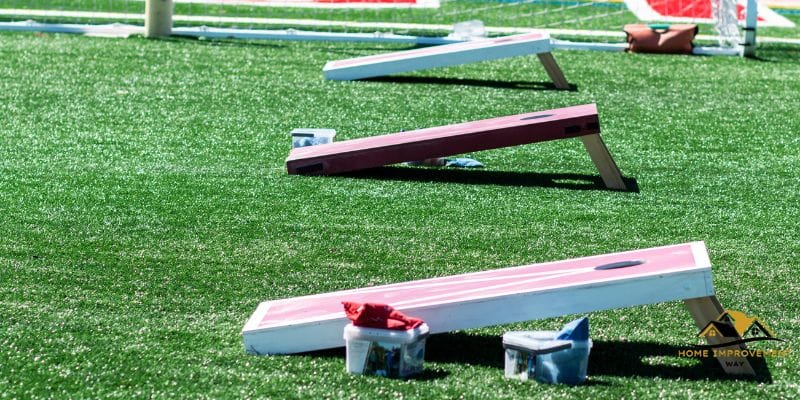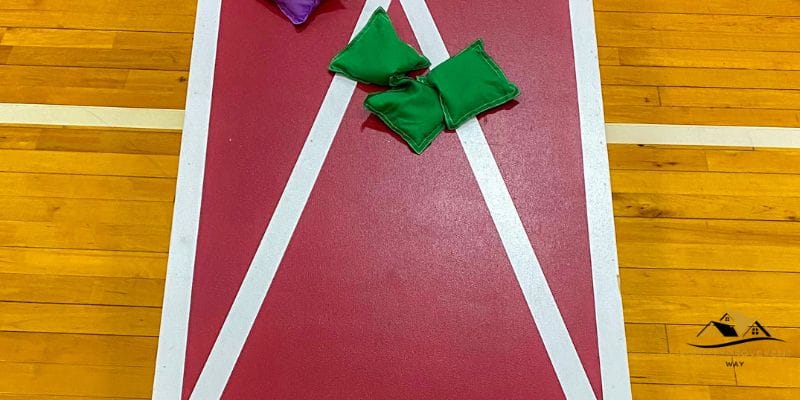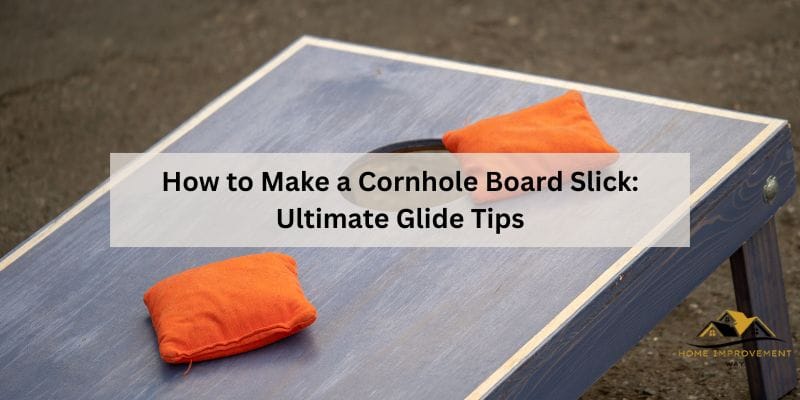To make a cornhole board slick, apply a high-gloss polyurethane finish or sand it smooth. Ensure the surface is clean before application for the best results.
Crafting a smooth and sleek surface on a cornhole board is essential for the perfect slide of bags during gameplay. A glossy surface not only enhances the game but also protects the wood from wear and weather conditions. Enthusiasts of cornhole often seek ways to make their boards as slippery as professional sets, striving for that satisfying glide.
This aspect is also crucial for the longevity of both the cornhole bags and the board itself. Through consistent maintenance and the right finishing techniques, turning your standard cornhole board into a slick playing surface can greatly improve your gameplay experience.
Cornhole Board Slickness: An Overview
The game of cornhole is a beloved pastime at tailgates, backyard BBQs, and tournaments, with the board’s surface playing a pivotal role in the overall experience. The right amount of slickness on a cornhole board can significantly elevate the game. This article sheds light on the importance of this aspect and the effect it has on the gameplay, providing a guide on how to achieve the ultimate glide for those bags.

Importance Of Slick Cornhole Boards
Understanding The Impact Of Slickness On Gameplay
To truly understand this balance, consider the following points:
- Consistency: A uniform surface ensures predictable bag movement, crucial for strategic gameplay.
- Climate Adaptability: Boards that maintain slickness in various weather conditions allow for year-round play.
- Preference Adaptation: Players may adjust the board to their liking, customizing the slickness level for preferred play styles.
Choosing The Right Materials
When it comes to building the perfect cornhole board, the devil is in the details. The materials chosen for your project are not just about aesthetics; they’re crucial for playability. By selecting the ideal wood and mastering sanding techniques, you can ensure your cornhole board is not only visually appealing but also delivers a slick surface that cornhole bags will effortlessly slide across.
Selecting The Ideal Wood For Cornhole Boards
- Birch: Provides a smooth finish & durability.
- Maple: Known for its strength and even texture.
- Sanded Plywood: Less expensive, but be cautious of potential warping.
Sanding & Smoothing Techniques For Optimal Slickness
- Sand in the direction of the grain to avoid scratches.
- Use an orbital sander for even pressure distribution.
- Manually finish edges and corners with a fine-grit sandpaper.
Applying The Perfect Finish
Perfecting the finish on your cornhole board not only amplifies its aesthetic appeal but significantly impacts its playability. A slick surface is key to a great game, allowing bags to slide smoothly into the hole for that satisfying score. Achieving that slickness involves careful application of the right finishing products to make every slide, every game, unforgettable.
Role Of Wood Sealers In Enhancing Slickness
- Choose a high-quality sealer that suits exterior use, ensuring the board can withstand the elements.
- Apply evenly across the surface of the board. Use a paintbrush or roller to get a consistent coat.
- Allow proper drying time before applying additional coats. Rushing this step can result in a tacky finish that hinders the slickness.
Utilizing Polyurethane For Ultimate Glide
- Sand the surface of the board smoothly, starting with a medium-grit sandpaper and working up to a fine grit.
- Remove all dust with a tack cloth. Any debris left on the board will interfere with the smooth finish.
- Apply a thin layer of polyurethane using a high-quality brush or foam pad, ensuring long, even strokes.
- Let the first coat dry thoroughly, then lightly sand with fine-grit sandpaper and clean again with a tack cloth.
- Apply additional coats, typically two to three are sufficient, repeating the sanding and cleaning process between each coat.
- Once the final coat is dry, buff the surface to a high shine, if desired, for the smoothest gameplay.
Maintaining And Enhancing Slickness
Turning your cornhole board into a gliding surface is essential for the perfect pitch. Achieving that slick, smooth finish isn’t just about the initial setup—it’s an ongoing process. Proper maintenance and the application of select techniques ensure your board stays in prime condition, allowing bean bags to slide gracefully into victory. Let’s explore how to keep that board impressively sleek and ready for game day.
Regular cleaning and maintenance tips list
- Wipe down the surface after every game to remove dirt and debris.
- Use gentle cleaners—a mix of warm water and mild soap will do the trick without damaging the finish.
- Regularly inspect for damage such as cracks or chips, which can affect the board’s smoothness.
- Avoid exposure to elements by storing the board in a cool, dry place.
- Apply board polish every few games to replenish the surface’s slippy quality.
- Sanding the surface – Start with a coarser grit and progress to a fine grade for a super-smooth finish.
- Applying a quality finish – Use clear varnish or polyurethane to seal the wood and reduce friction.
- Waxing the board – A good-quality silicone spray or board wax delivers an extra slip to the surface.
- Upgrading to slick Cornhole bags – Pairing your board with high-quality bags can significantly improve the slide.
Cornhole Board Slickness: Professional Tips From Experts
Every seasoned cornhole player knows the importance of the right amount of slickness on their cornhole board. Achieving that perfect glide can make the difference between a slide-in and a stick-on. With expert advice and professional techniques, you too can have a cornhole board that meets the standards of the pros. Whether you’re a DIY enthusiast or a cornhole aficionado looking to refine your game, these tips will help you make sure your cornhole board has just the right level of slickness for optimal play.
Insights From Established Cornhole Board Builders
Expert Recommendations For Achieving The Ultimate Slickness
Experts recommend a meticulous approach to achieve that competition-grade slickness. Here is an organized breakdown of their advice:
- Quality Paint Job: Begin with a smooth paint coat. High-gloss latex paint often serves as a perfect base for the boards.
- Fine Sanding: After the paint dries, sand the surface. Start with 220-grit sandpaper and progress to finer grits, up to 400 or even 600 for the smoothest finish.
- Polishing: The application of specialized cornhole board polish or silicone spray helps reduce friction, increasing the board’s slickness.
- Consistent Maintenance: Regular cleaning and occasional reapplication of polish or wax will keep the slickness at an optimal level.
Integrating these expert recommendations into your board maintenance routine will ensure your cornhole board remains in top condition for those perfect slides and strategic plays. Remember that the environment also plays a role; humidity and temperature can alter the board’s behaviour, so adjust your game and maintenance practices accordingly!
Advanced Techniques For Slickness Enhancement
Discover cutting-edge tips to boost the slickness of your cornhole board for seamless play. Master the art of perfecting your board’s surface with strategies that promote an ultra-smooth glide, elevating the game experience.
Exploring Innovative Slickness Improvement Methods
- Using a hard, smooth surface laminate overlay on top of the wood.
- Applying a special blend of waxes or silicone sprays after the final paint coat.
- Integrating a fine texture such as sharkskin or a custom polymer that minimizes friction.
Experimenting With Alternative Finishing Products
| Finish Type | Properties | Expected Slickness Level |
|---|---|---|
| Polycrylic Finish | Water-based, crystal clear | Medium-High |
| Automotive Wax | Smooth, durable, adds gloss | High |
| Acrylic Lacquer | Fast-drying, mirror-like finish | Very High |
| Epoxy Resin | Thick, glassy, and heavy-duty | Extreme |
Troubleshooting Common Slickness Issues
Welcome to your go-to guide for troubleshooting common slickness issues with your cornhole boards. Creating that perfect slick surface is crucial for a slide-right-into-the-hole gameplay experience, but sometimes, achieving that silky-smooth glide can be tricky. Whether you’re a cornhole enthusiast or gearing up for a backyard tournament, understanding how to tackle the obstacles that prevent your board from being slick is key to elevating your game.
Addressing Common Slickness Problems
Encountering issues where your cornhole board isn’t as slick as it ought to be? Let’s address those concerns spot on! Frequent problems include a surface that’s too rough, insufficiently cured sealant, or the pesky buildup of dust and debris.
- Surface Roughness: If the surface feels like it’s dragging, it likely needs a thorough sanding. Start with a coarse grit sandpaper and progressively move to a finer grit to achieve a glass-like finish.
- Sealant Curing: Freshly applied sealants or paint require adequate time to cure. Rushing this process can lead to a tacky feel. Always allow for the recommended drying time.
- Build-up and Grit: Keep your boards debris-free. A swift wipe with a microfiber cloth can eliminate particles that hinder the board’s slickness.
Once these issues are managed, applying a high-quality polish or wax designed for cornhole boards will often restore the sought-after slickness.
Overcoming Obstacles In Achieving Slickness
When persistent slickness problems arise, consider taking additional steps to overcome these challenges.
- Degraded Finish: Weather elements and time might degrade your cornhole board’s finish. Reapplying a clear topcoat not only protects the wood but also boosts the slickness.
- Humidity: High humidity can affect the playability of a board. Use climate-controlled storage or silica packets to control moisture levels.
- Improper Care: Regular maintenance is critical. Avoid leaving boards exposed to the elements and apply specialized cornhole board wax every few games.
Whether your board is brand new or has seen a few seasons of play, implementing these strategies ensures top-notch slickness for uninterrupted fun.

Frequently Asked Questions For How To Make A Cornhole Board Slick
What Materials Make A Cornhole Board Slippery?
To make a cornhole board slippery, professional-grade silicone sprays or specialized cornhole board polishes are commonly used. These products reduce friction, allowing bags to glide smoothly over the surface.
How Often Should I Polish My Cornhole Board?
You should polish your cornhole board every few games or whenever the surface starts to feel sticky or rough. Regular maintenance ensures consistent play and longevity of the board’s slick nature.
Can Weather Affect Cornhole Board Slickness?
Yes, humidity and temperature can affect the board’s slickness. High humidity can make the board sticky, whereas colder temperatures might make it less smooth. It’s essential to adjust board treatment according to weather conditions.
Is Sanding Necessary To Slicken A Cornhole Board?
Sanding is a crucial step before applying any slick-finish products. It smooths out imperfections and opens up the wood pores to better absorb the slickening agents.
Conclusion
Crafting the perfect slick cornhole board can transform your game. Embrace these tips to achieve the right slide in your tosses. Remember, a smooth surface and correct technique are key. Now, with your upgraded board, you’re set to impress at your next backyard bash.
Get ready to slide to victory!

